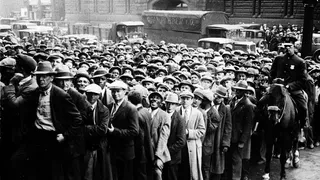July 2, 2008
Gotham laments closure of popular Meatpacking District eatery
Cody Lyon READ TIME: 5 MIN.
On the Wednesday evening before Gay Pride weekend in the city, the Meatpacking District was alive with activity. Finely dressed pedestrians made their way along cobblestone streets while window shoppers admired the latest fashions in freshly sandblasted buildings. All the while, sounds of laughter, conversation and clinking glass from Pastis and other polished restaurants filled the air.
But deep in the heart of this exclusive neighborhood, on Gansevoort Street, a pair of lone rainbow flags crowned the green awning at Restaurant Florent. Albeit crowded, the air of sadness over the popular eatery's closure consumed all who entered.
"He [owner Florent Morellet] is so overwhelmed right now," a busy hostess said after EDGE asked her about the possibility of speaking to him. "You know we only have a few days left."
The paint on the window told the whole story.
"Serving 24 hours until the bitter "sweet" end on June 29," it read.
After 23 years of serving countless steak frites, muscles and Boudin Noire in an area more known for beef racks, leather daddy's, transgender prostitutes, club kids and Hogs and Heffers, the modern landmark 24 hour French diner that served the fashionable alongside the "freaky" has closed its doors. News reports account Morellet signed a lease for $6,000 in 1995. The landlord reportedly sought to increase the rent to around $700,000 per year-or $58,000 per month-this past year. And Morellet was left with little choice but to close shop after a period of unsuccessful negotiation.
Skyrocketing rents in the Meatpacking District are certainly nothing new, but Florent regular Scott Woodward, a long-time downtown resident and branding executive, was among those who expressed sadness.
"Raising the rent six times the current monthly rent is crazy," he said as he pointed to the gentrification that has transformed the once seedy neighborhood. "Just what we need, another Stella McCartney boutique."
In addition to a lack of good eats, Florent's closure has left some angry. The Meatpacking District was once seen by many LGBT New Yorkers as a creative enclave, but some seem resigned to what they see as part of an ongoing trend in a city where charm, mystery and character often succumb to market forced controlled by corporate and other moneyed interests.
Antoine Maisini opened Eastern Bloc in the East Village two years ago with two fellow bartenders. The France native was quick to note the increasingly difficulty in getting any sort of service industry business off the ground in Manhattan.
"You have to have multi-million dollar backing to start almost anywhere in the borough," Maisini said.
He added he feels most new bars; restaurants and clubs that open in the city have a more of a polished corporate feel to potentially avoid the same market forces that appeared to spark Florent's closure. And among the many who mourn the loss of the Meatpacking District mainstay, there is even deeper sadness and resignation over the cultural change they contend it represents.
Promoter and artist John Lovett co-hosted the weekly "Pork" party at the Lure each week in the 1990s. He agreed that rising real estate values limited nightlife innovation, business and even art itself in Manhattan.
"There's so much pressure about money, you can't build anything interesting or daring," Lovett said as he recalled walking around the Meatpacking District in full leather regalia in broad daylight during the heyday of the Lure, the Spike and Jackie 60's. "The radical-ness of New York has sort of disappeared."
Morellet's decision to open his restaurant when and where he did was radical in its own right. The rumblings of change began to take hold on the "radical" area bounded by 14th Street to the north, Gansevoort Street to the south, the West Side Highway to the west and Ninth Avenue to the east in the late 1990s. And with the demise of the meatpackers, a hunger by investors for new opportunities coupled with a Manhattan real estate boom quickly decreased the days of the seedier and "mysterious" ambience of the Meatpacking District.
"Florent and Pastis are perfect juxtapositions," writer and performer Idris Mignot, a former Florent server and bartender during a period in the 1990s, said. "Florent... created a mood, a feeling and a place while Pastis... [is] the bigger, stronger 'Johnny come lately' that exudes all that is new and pseudo-fabulous."
He continued to lament what he described as not only the disappearance of the grit and rough edge of the Meatpacking District, but the noticeable change of the "old school" downtown scene.
"The underbelly is gone, the excitement is gone, the diva at the velvet rope is gone, all replaced by the bottle publicist in stilettos or bad wedgies and an empire waist trapeze dress in that awful print," Mignot said with a hearty laugh. "Florent symbolizes a time when you didn't know what to expect. You didn't know what was around the next corner."
Regardless of Florent's physical demise, countless memories and fond-often outrageous recollections that are uniquely New York will remain alive for the ages.
Clara Huange was among those who frequented the eatery. She was an art director at POZ Magazine, and she quipped the restaurant was her staff's cafeteria.
"I had a romance with Florent during the entire time I worked at the magazine" Huange said as she recalled the mussels and frites, veggie burgers, egg Sophie and steak and eggs.
Writer and actor Nora Burns, who participated in Florent's closing performances over the past few months, Denial, Depression and Acceptance, said she loved going there after a night out at Jackie 60, Clit Club or Mars. She left New York in 2002, but she told EDGE "Florent still feels like home."
Mignot shared his own stories. He recalled a last minute costume design for his bartending shift during the annual Bastille Day celebration, a bygone street fair Morellet himself organized. Mignot based his design on the blood sausage menu item served alongside apples and onions.
"When I got to Florent in a skimpy black bathing suit, I fashioned a necklace out of apples and onions," he said. "I called myself Booty Noir."
Another waiter wore croissants as pig tails. Mignot said the staff-and their zany fashion antics-were half the reason people came to dine. He further noted the graveyard shift, from midnight until 8 a.m., was the most fun and spontaneous time to be in Florent. And Mignot credits Morellet with encouraging his staff's outrageous and creative nature.
Another former patron, DJ Larry Tee, recalled a life and death incident late one night while dining at Florent with friends who were visiting from Amsterdam. He was trying to impress them and suddenly began to choke on a piece of Florent's famous steak that became stuck in his windpipe.
"It didn't take me but a second to remember that being alive is much better than being cool, and someone gave me a rib thrust, sending that piece of meat flying, I caught it," he said.
Sherry Vine also shared the good times she and her friends had at Florent-especially every Tuesday night after a night at Jackie 60.
"Florent was always so generous and supportive of the queens," she told EDGE in an e-mail from Estonia. "Bastille Day was where I met Joey Arias and invited [him] to perform at Bardo. Sadly, there's just no place left in Manhattan for freaks and artists."
Cody Lyon is a New York freelance writer whose work has appeared in a number of national daily newspapers and New York weeklies. Lyon also writes a political opinion blog at http://codylyonblogolater.blogspot.com







